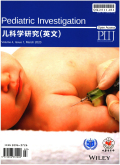- 钛学术文献服务平台 \
- 学术期刊 \
- 医药卫生期刊 \
- 妇产科学与儿科学期刊 \
- 儿科学研究(英文)期刊 \
Staging surgery for intraventricular bilateral giant Rosai-Dorfman disease in children
Staging surgery for intraventricular bilateral giant Rosai-Dorfman disease in children
基本信息来源于合作网站,原文需代理用户跳转至来源网站获取
摘要:
Introduction::Rosai-Dorfman disease (RDD) is an uncommon, benign, and idiopathic histiocytic proliferative disorder. Multiple intracranial RDD is extremely rare and treatment varies.Case presentation::A 9-year-old girl was admitted with 3-month history of blurred vision and facial paralysis, a 2-month history of recurrent giggle, and cognitive impairment. Computed tomography and magnetic resonance imaging scans revealed bilateral ventricular masses based on the dural membrane and the diameters of the masses were 9.1 cm and 9.2 cm, respectively. The lesions were completely removed with staging surgeries. Fifteen months after operation, blurred vision was still present but facial paralysis and giggle and cognitive impairment disappeared. Imaging examinations suggested that there were no new or recurring lesions.Conclusion::For multiple large intracranial masses, surgical treatment is necessary and staged surgery benefits perioperative safety. Active follow-up with magnetic resonance imaging is necessary.

推荐文章
淋巴结外Rosai-Dorfman病临床病理观察
Rosai-Dorfman病
淋巴结外
免疫组织化学
鉴别诊断
结外Rosai-Dorfman病
组织细胞增生症
窦
诊断
鉴别
耳廓Rosai-Dorfman病1例
Rosai-Dorfman病
窦组织细胞增生伴巨大淋巴结病
耳廓肿块
鉴别诊断
内容分析
关键词云
关键词热度
相关文献总数
(/次)
(/年)
引文网络
引文网络
二级参考文献 (0)
共引文献 (0)
参考文献 (0)
节点文献
引证文献 (0)
同被引文献 (0)
二级引证文献 (0)
2022(0)
- 参考文献(0)
- 二级参考文献(0)
- 引证文献(0)
- 二级引证文献(0)
研究主题发展历程
节点文献
Intraventricular
Pediatric
Rosai-Dorfman disease
Sinus histiocytosis
Staging surgery
研究起点
研究来源
研究分支
研究去脉
引文网络交叉学科
相关学者/机构
期刊影响力
儿科学研究(英文)
主办单位:
中华医学会
出版周期:
季刊
ISSN:
2096-3726
CN:
10-1593/R
开本:
大16开
出版地:
北京市西城区金融大街27号投资广场A座2101
邮发代号:
创刊时间:
2017
语种:
eng
出版文献量(篇)
198
总下载数(次)
0
总被引数(次)
26
期刊文献
相关文献
推荐文献
- 期刊分类
- 期刊(年)
- 期刊(期)
- 期刊推荐

 免费查重
免费查重










